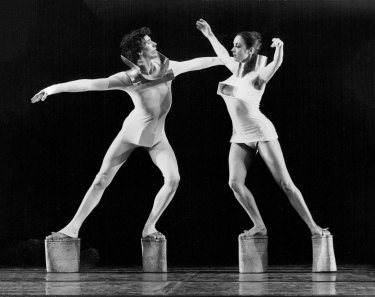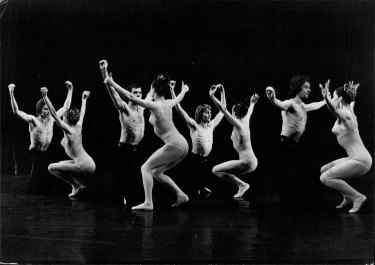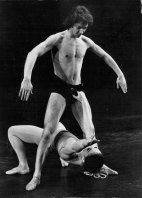By Romola Costantino
First published in The Sydney Morning Herald on May 31, 1972
Bolder than bold ballet
More contemporary than all other modern dance companies to date is the Nederlands Dans Theater, which opened at the Regent Theatre to a capacity “beautiful people” audience last night.

Kathy Grosschalk and Nils Christe in the Space Age scenes from Mutations. May 30, 1972.Credit:Stuart William MacGladrie
The three ballets on the program showed three strongly diversified styles in stark contrast, each brilliantly realised.
Electronic sound tapes by Stockhausen set the key for “Mutations,” a long ballet which employs filmed slow-motion dance sequences, a catwalk up and down which the dancers writhe and scramble as if gravity had been up-ended and they were stuck to a vertical wall, and, of course, nudity, about which Galileo’s famous remark once again proved apt — “Eppur si muove.”

The Nederlands Dans Theatre rehearse “Grosse Fuge” on June 5, 1972.Credit:Antony Matheus Linsen
Gone are the days when “Hair” was the boldest thing about town and frontal nudity had to be motionless. The two naked dancers of “Mutations,” Anja Licher and Gerad Lemaitre, dance strenuously, as do three other young men in a vigorous pas de trois.

Frans Vervenne and Lia Haeken rehearse.Credit:Antony Matheus Linsen
The effect has to be disconcerting to those who feel that a dancer should control every part of the body, while here, to put it simply, certain parts of female and male anatomy move independently. This is sufficient argument in favour of the body stocking in which the whole human form can express itself in disciplined dance.
The audience took it all without a murmur, and indeed their clapping seemed to me to be more enthusiastic for the classically romantic ballet “After Eden,” which followed the interval.
But then, nudity apart, I found “Mutations” to be an inflated and pretentious overdose of symbolism, with its tubular chromium-plated decor, its blood-smeared dancers, its film screens showing the same dances in another dimension, and its background sound which bore no relationship to the actions.
The choreography had some striking effects, and the blending of classical ballet movements with modern dance was outstandingly successful, with never a jarring movement yet both styles clearly in evidence.
This was notable again in “After Eden,” which was not barefoot and was strongly classical while it had an expressive simplicity which was beautifully evoked by Marian Sarstadt and Gerard Lemaitre.
This was the highspot of the program which ended with a lively but fairly typical modern jazz ballet — complete with strobe-effect finale — which showed the whole company to be a fine, lithe young team.